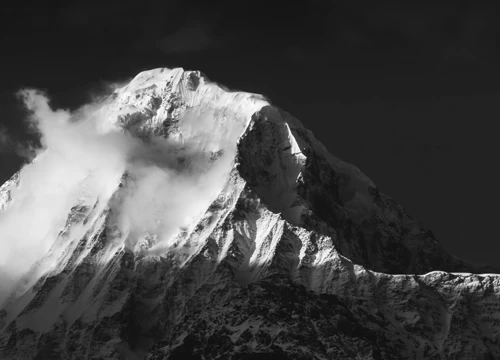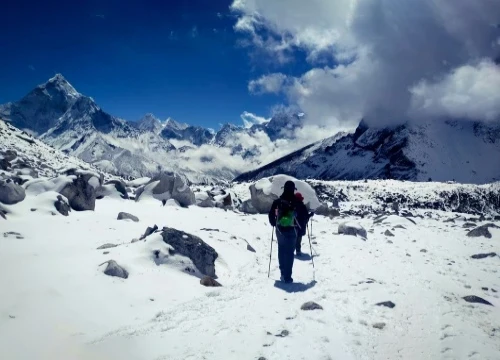Environmental Consequences of Human Waste on Everest Camps
The sheer number of trekkers on Mount Everest has taken a toll on the environment, particularly in the form of human waste. With limited infrastructure to handle the waste generated, the camps along the trekking route have become hotspots for pollution.
One of the most significant environmental consequences of human waste is the contamination of the water sources. As trekkers and climbers relieve themselves in open areas, the waste seeps into the soil and eventually finds its way into rivers and streams. This pollution affects the delicate ecosystem of Mount Everest, endangering the flora and fauna that depend on these water sources.
Additionally, the accumulation of human waste at the campsites poses a threat to the pristine beauty of the mountain. The sight and smell of waste can be disheartening for trekkers and climbers who come to experience the natural splendor of Everest. It also undermines the efforts of conservationists and organizations striving to preserve this unique and fragile environment.
To combat these environmental consequences, it is crucial to implement proper waste management systems that can handle the increasing number of trekkers. This includes the establishment of designated toilet facilities and waste disposal mechanisms that are both efficient and environmentally friendly.
Health Risks Associated with Contaminated Water Sources
Apart from the environmental impact, the inadequate waste management on Everest also poses serious health risks to trekkers. Contaminated water sources can lead to waterborne illnesses, which can be debilitating and potentially life-threatening in high-altitude conditions.
When trekkers consume water from contaminated sources, they expose themselves to various pathogens and bacteria. These microorganisms can cause diseases like diarrhea, cholera, and dysentery, which can severely affect a trekker's physical well-being and jeopardize their ability to complete the journey.
Furthermore, contaminated water can also lead to dehydration. As trekkers may be hesitant to drink water from natural sources due to the risk of contamination, they may not consume enough water to stay properly hydrated. Dehydration at high altitudes can exacerbate the symptoms of altitude sickness and compromise a trekker's overall health.
To mitigate these health risks, it is essential for trekkers to prioritize safe hydration practices. This includes relying on bottled water, which undergoes rigorous purification processes to ensure its safety. By opting for bottled water, trekkers can minimize the chances of consuming contaminated water and safeguard their health during the challenging Everest trek.
Importance of Proper Waste Management Systems on Everest
To address the pressing issue of waste management on Mount Everest, it is crucial to recognize the importance of implementing proper systems. The existing infrastructure is ill-equipped to handle the increasing number of trekkers, leading to unsanitary conditions and environmental degradation.
One of the key aspects of proper waste management is the establishment of designated toilet facilities. Trekkers should be encouraged to use these facilities instead of relieving themselves in open areas. These toilets should be strategically placed along the trekking route to ensure convenience and accessibility.
In addition to toilet facilities, waste disposal mechanisms should be implemented to handle all forms of waste generated by trekkers. This includes both organic waste and non-biodegradable items, such as plastic bottles and packaging. Proper waste segregation and recycling practices should be encouraged to minimize the environmental impact.
To ensure the long-term success of waste management efforts, education and awareness programs should be conducted for trekkers. By educating trekkers about the importance of responsible waste disposal, we can foster a culture of sustainability and minimize the impact on the Everest ecosystem.
The Role of Bottled Water in Ensuring Safe Hydration for Trekkers
With the health risks associated with contaminated water sources, bottled water plays a crucial role in ensuring safe hydration for trekkers on Mount Everest. The purification processes undergone by bottled water brands are designed to eliminate harmful bacteria and contaminants, making it a reliable source of safe drinking water.
Bottled water provides trekkers with peace of mind, knowing that they are consuming water that has been treated and tested for safety. This is especially important in high-altitude environments, where the body's hydration needs are increased, and access to safe drinking water may be limited.
Moreover, bottled water offers convenience and portability for trekkers. It is easy to carry and can be consumed on the go, allowing trekkers to stay hydrated throughout their journey. The packaging of bottled water also ensures its integrity, protecting it from contamination and ensuring its quality.
While some may argue that the use of bottled water contributes to plastic waste, it is essential to balance the need for safe hydration with sustainable practices. The key lies in responsible waste disposal and recycling. Trekkers should be encouraged to dispose of their empty bottles in designated recycling bins, minimizing the environmental impact.
Advantages of Using Bottled Water in High-Altitude Environments
In high-altitude environments like Mount Everest, the use of bottled water offers several advantages for trekkers. The unique challenges presented by high altitudes make it even more critical to prioritize safe hydration practices.
Firstly, bottled water provides a reliable and consistent source of hydration. Natural water sources at high altitudes may be scarce or contaminated, making it risky for trekkers to rely solely on them. Bottled water ensures that trekkers have access to safe drinking water throughout their journey, reducing the risk of dehydration and associated health issues.
Secondly, the packaging of bottled water is designed to withstand the harsh conditions of high altitudes. The bottles are durable and resistant to puncture, ensuring that trekkers can carry them without the fear of leaks or spills. This reliability is crucial in remote areas where access to clean water may be limited.
Lastly, the convenience of bottled water cannot be underestimated. Trekkers often have limited time and energy during their ascent, and accessing safe drinking water should be hassle-free. Bottled water can be easily stored in backpacks and accessed whenever needed, allowing trekkers to stay hydrated without disruptions to their journey.
Challenges and Solutions for Waste Management on Everest
Waste management on Mount Everest poses several challenges due to the unique conditions and limited infrastructure. However, with the right solutions, it is possible to address these challenges and ensure a more sustainable approach to waste disposal.
One of the primary challenges is the lack of proper waste disposal mechanisms. As trekkers and climbers continue to flock to Everest, the waste generated far exceeds the capacity of the existing infrastructure. This leads to waste accumulation at campsites and along the trekking route, which not only degrades the environment but also poses health risks.
To overcome this challenge, it is crucial to invest in the development of efficient waste disposal mechanisms. This includes the installation of waste bins and recycling facilities at strategic locations. These facilities should be regularly maintained and emptied to prevent overflow and ensure proper waste management.
Another challenge is the lack of awareness and education among trekkers regarding responsible waste disposal. Many trekkers may not fully understand the impact of their actions on the environment and may not realize the importance of proper waste management. Education programs and awareness campaigns can play a crucial role in addressing this challenge and fostering a culture of sustainability.
Furthermore, collaboration between government bodies, non-profit organizations, and local communities is essential in implementing effective waste management solutions. By working together, these stakeholders can pool their resources and expertise to develop comprehensive waste management strategies that address the unique challenges of Mount Everest.
Initiatives and Organizations Promoting Responsible Waste Disposal on Everest
Several initiatives and organizations are actively working towards promoting responsible waste disposal on Mount Everest. These efforts aim to raise awareness, implement sustainable practices, and ensure the preservation of the Everest ecosystem for future generations.
One such initiative is the "Clean Everest Campaign" launched by the Nepal Mountaineering Association (NMA). This campaign focuses on raising awareness among trekkers and climbers about the importance of responsible waste disposal. It also emphasizes the need for collaboration between climbers, tour operators, and local communities to maintain the cleanliness of the mountain.
Similarly, the Sagarmatha Pollution Control Committee (SPCC) is actively involved in waste management on Everest. They have implemented waste treatment plants at base camps and trekking routes, allowing for the proper disposal and recycling of waste generated by trekkers. The SPCC also conducts regular clean-up drives to clear waste from campsites and sensitive areas.
In addition to these initiatives, various non-profit organizations and environmental groups are working towards sustainable waste management on Mount Everest. They conduct research, develop innovative solutions, and advocate for responsible practices. These organizations play a crucial role in driving change and ensuring the long-term preservation of the Everest ecosystem.
Tips for Trekkers on Reducing Waste and Minimizing Environmental Impact
As trekkers, we all have a responsibility to minimize our environmental impact and ensure the preservation of Mount Everest for future generations. Here are some tips for reducing waste and practicing sustainable habits during your Everest trek:
- Pack light and avoid unnecessary packaging: Opt for lightweight and reusable containers for food and drinks, reducing the need for single-use plastic packaging.
- Bring a reusable water bottle: Instead of relying solely on bottled water, carry a reusable water bottle that can be refilled at designated water stations or using water purification methods.
- Dispose of waste responsibly: Use designated waste bins for different types of waste and separate recyclables from non-recyclables. Avoid littering or leaving waste behind at campsites or along the trekking route.
- Practice "Leave No Trace" principles: Minimize your impact on the environment by following the seven principles of Leave No Trace, which include properly disposing of waste, respecting wildlife, and staying on designated trails.
- Support eco-friendly tour operators: Choose tour operators that prioritize sustainable practices and responsible waste management. Research and inquire about their waste disposal policies before booking your trek.
- Educate yourself and others: Stay informed about the environmental challenges faced by Mount Everest and share your knowledge with fellow trekkers. Encourage others to adopt sustainable habits and be mindful of their impact on the environment.
By following these tips, we can collectively reduce waste, preserve the natural beauty of Everest, and ensure a more sustainable trekking experience for all.
Conclusion: The Importance of Sustainable Practices for Preserving the Everest Ecosystem
The impact of human waste on Everest camps and the necessity of bottled water for trekkers are two interconnected issues that demand our attention. The increasing number of trekkers, combined with inadequate waste management







